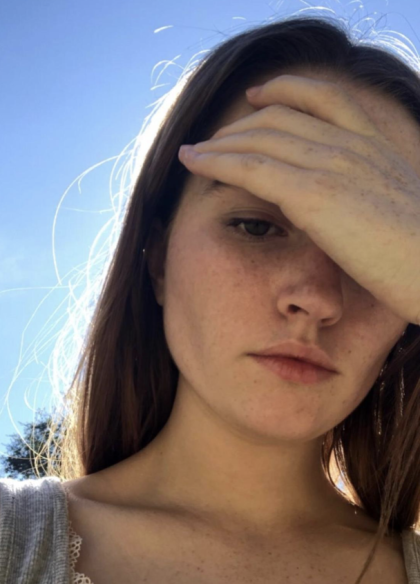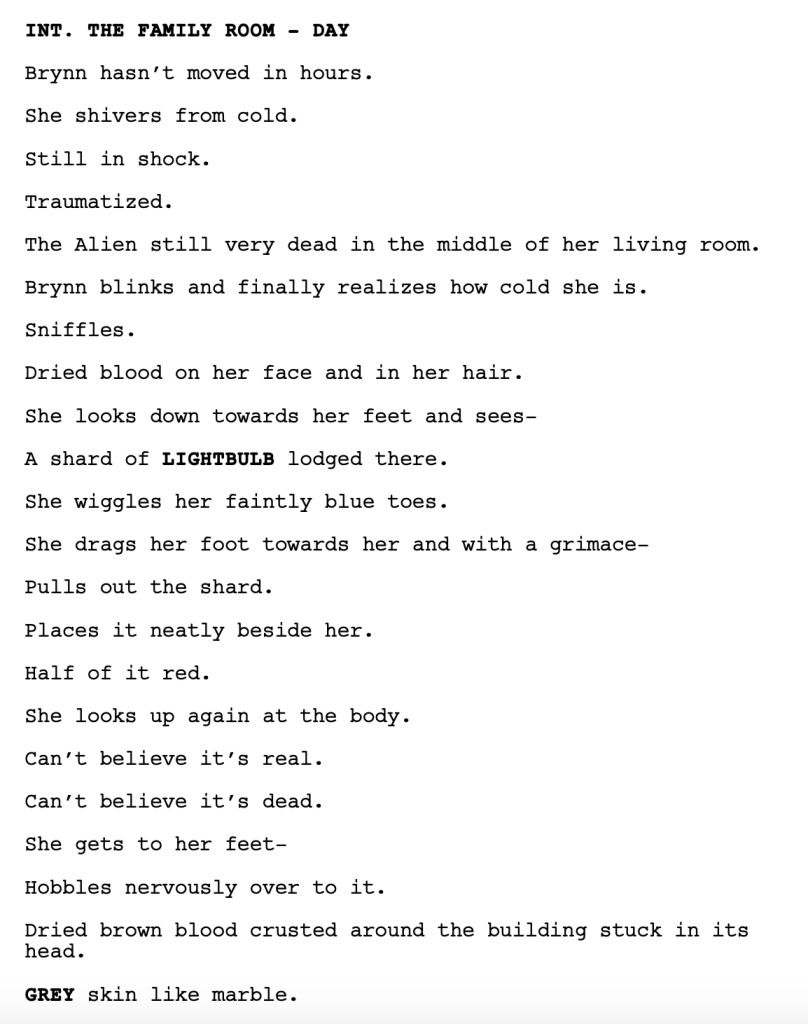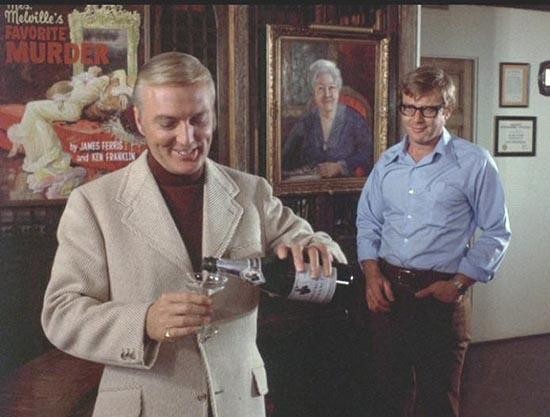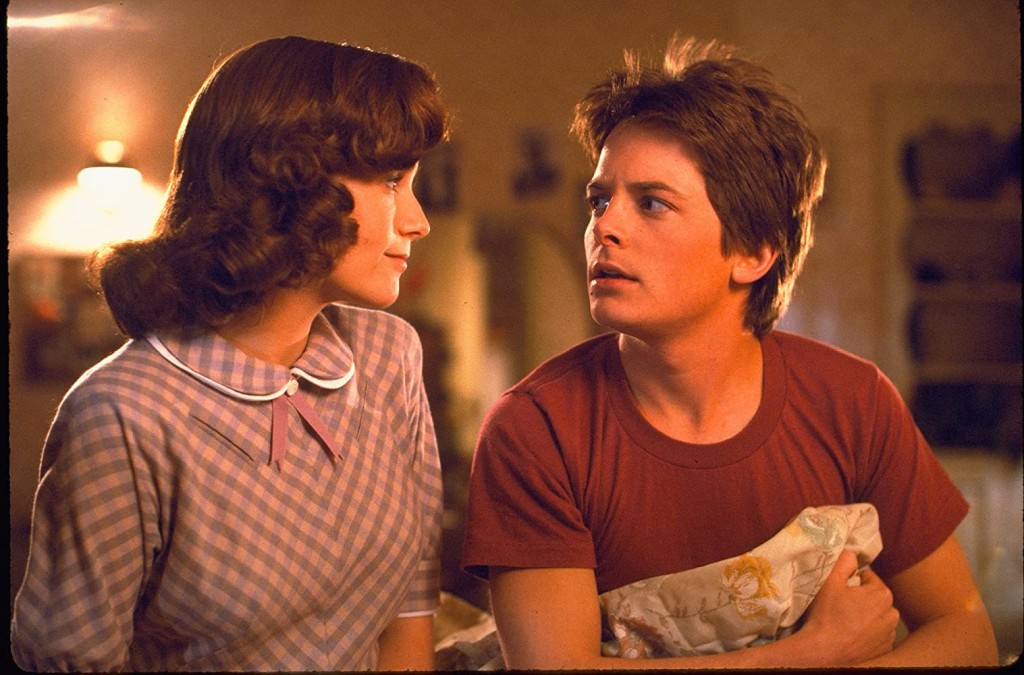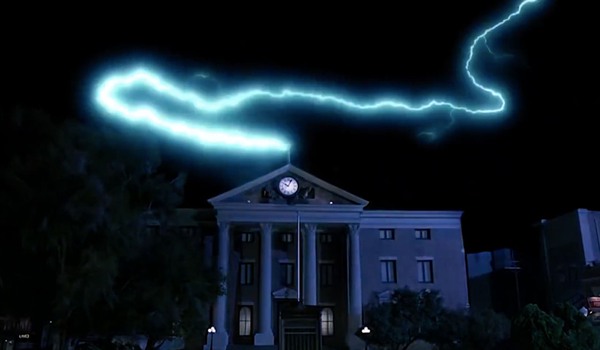Brian Duffield’s latest script asks the question, “Who needs dialogue?”
Genre: Horror/Sci-Fi
Premise: An exiled anxiety-ridden homebody must battle an alien who’s found its way into her home.
About: This is Brian Duffield’s latest script, which he will be directing. He’s got rising star Kaitlyn Dever (Booksmart, Unbelievable) starring in the title role. I don’t think I have to remind everyone of my love for Brian Duffield. He’s one of my favorite screenwriters!
Writer: Brian Duffield
Details: 90 pages
Will the writer with the most scripts ever to appear in my Top 25 add yet another script to the list? Let’s find out!
20-something Brynn lives all by herself in a house out in the woods. She spends her days buying those little holiday village buildings online and adding them to her growing little miniature town. She also likes to write letters to friends and dance by herself to music from the 30s on her record player. Yeah, Brynn doesn’t exactly live the FOMO life.
Brynn is also not well liked in town. Whenever she has to go into town to send her letters, we see people staring her down, giving her the evil eye. We’re not told why. But Brynn doesn’t have any friends around here. Which makes it sad when she visits her dead mother’s grave. Even there, people from other funeral processions stare.
One night, while Brynn is sleeping, she hears noise downstairs. When she goes to inspect the noise, she sees that it’s a gray alien. The alien spots her and begins chasing her around the house, climaxing in a face-off in the living room. Brynn takes one of the village buildings she collects and cracks it across the alien’s face, killing it instantly!
As soon as the alien dies, all the power, including the battery in her car, goes dead. It appears to have released some sort of EMPT bomb when it died. Brynn rides her bike to town the next morning to tell the police, but all of them stare at her coldly. Clearly, the police hate Brynn for some reason. By the way, there’s been no dialogue this entire movie so far.
Brynn decides that the only course of action is to leave town. But when she gets on the local bus, one of the passengers attacks her! Clearly, it is connected to the alien from her home somehow. The bus screeches to a stop and Brynn runs back to her town, having no choice but to go back home.
Once at the house, her worst fears come true. Aliens come back to pick up their own. These are much bigger, much scarier, aliens. And it takes every ounce of fight Brynn has left to elude them. But they eventually capture her. In our big final climactic moment, an alien places its finger on Brynn’s forehead, which sends us into a flashback of how Brynn ended up alone in this house, hated by the town. It acts as some sort of catharsis for Brynn, who, theoretically, can now move on with her life. But will she?
Let me show you what an average page of this screenplay looks like…
Brian Duffield may be the most minimalist screenwriter in Hollywood. Most of his action paragraphs in this script are one line. At most two. As a point of reference, I just got done with a screenplay consultation where I had to tell the writer he should probably scale back all the 8-line paragraphs.
Not enough writers think about the load of work they place on the reader. The more dense with text the pages are. The more characters there are in the story. The more plot there is. The more exposition that needs to be conveyed. All of these things factor into the workload you’re placing on the reader. The higher the workload, the better the script has to be because you’re making the reader work harder. And when the reader works harder, they want to be rewarded for that extra work.
That doesn’t mean every script should have two characters, a super-lean writing style, a thoughtless plot, and zero exposition. Writing a script like that has its own challenges, namely that ‘too simple’ can quickly become ‘too boring.’ All I’m saying is ‘workload’ is one of the factors you want to take into account before writing your script. Or choosing your concept. Because there is something to be said about making the reading experience easy.
Nobody understands that concept better than Duffield. I would even say that it was a key ingredient to his success. Nobody ever read a Brian Duffield script and said, “Man, that was such a long tedious read.” You may not have liked it, but it only took 60 minutes out of your life. Compare that to the post traumatic stress I’m still experiencing after the 4 hour battle I had with the “Mank” script.
As for the story itself, I have mixed feeling about No One Will Save You. I always wanted to keep reading. But I’m not sure I was satisfied with the payoff. In fact, I don’t know if I understood it. I’m going to reserve my thoughts about that to comments so that I don’t spoil anything here. If you understood the ending, head down to the comments so we can discuss.
My main issue with No One Will Save You is that 90% of it is running from one location to another. It may be from home to a bus stop. It may be from the kitchen to the living room. There’s only so much of “Brynn scurries behind the refrigerator” a reader can. It reminded me of one of my least favorite of Duffield’s scripts, The Babysitter, which also had the main character running around and hiding a lot.
Whenever I read an action script, which is essentially what this is, I’m looking for unique or stand-out set pieces. If you can come up with 4-5 inventive set pieces in a script like this, you can make a good movie. But if it’s all just running from one hiding spot to another, there’s no structure to that. Point A to Point B gets repetitive quickly.
No One Will Save You has one stand-out set piece, which occurs on the bus when Brynn is trying to escape town. The mailman (who was set up earlier as a creepy guy) ends up getting on the bus as well and we see him seated far back behind Brynn, who is unaware of his presence. As time goes on, we see him keep moving closer and closer to her, moving up from seat to seat. It’s super creepy and we’re screaming at Brynn to turn around. Of course, she doesn’t until it’s too late and he attacks her. That was a fun scene. But that was the only true set piece scene in the script. I wish there had been more.
I will say this was better than the similarly-themed “Trespasser” from a few weeks back. Much better. So there’s that.
Part of me reads a script like No One Can Save You and thinks, “This is a 45 minute movie.” Most scripts are around 20,000 words. This is maybe 12,000. Is that enough meat for a movie? I’m not convinced it is.
However, the other option is that Brian Duffield understands this generation better than the rest of us. He knows that nobody has time. He knows that everybody has options. So he writes in a way that’s quickly digested. And his movies move in a way that allow them to be consumed quickly. Should we be resisting this style or should we be following his lead?
[ ] What the hell did I just read?
[x] wasn’t for me
[ ] worth the read
[ ] impressive
[ ] genius
What I learned: There is no dialogue in this movie. There’s no doubt that this had a huge influence on why Duffield chose to convey the action via extreme minimalism. There’s no way to make a reader angrier than a script with little-to-no dialogue and BIG CHUNKY DESCRIPTION PARAGRAPHS. That’s every reader’s worst nightmare. Dialogue is the fastest part of the script to read. When you eliminate it, it takes three times as long to read the screenplay. Duffield identified that issue and curtailed the action lines so that the script still read fast. Smart move on his part.
Hollywood’s crusade to make it impossible to know when and where any TV show or movie is debuting continues. Apparently, Army of the Dead came out this weekend. If you’re like me, you were under the impression that Army of the Dead was a Netflix movie. You were also under the impression that Netflix movies debut on… Netflix. But not Army of the Dead, apparently. Army of the Dead debuted in theaters instead of on the service that produced it. Confused? When they said ‘streaming wars’ I didn’t know that the war was against us.
HBO Max isn’t doing much better. I was shocked when I opened the app this weekend and saw… “Those Who Wish Me Dead.” I had no indication that this movie was coming out. It appeared out of nowhere, as if by magic. Some people may think this is cool. But there’s a psychological component to dropping movies on audiences out of nowhere. They think the movie must be bad because they’ve been conditioned to believe that big important movies are hyped up beforehand.
Netflix, which drops movies out of nowhere all the time, arguably changed this belief. But now Netflix is debuting movies in theaters! So what the hell is going on?? And as long as I’m ranting about streaming, I finally canceled my Apple TV+ subscription. They didn’t have a single show or movie I’d rate above a “wasn’t for me.” The whole reason I got the subscription was for that cool looking sci-fi show, Foundation. It’s been two years and I’m still waiting for the first episode!
Luckily, we’re finally about to get real movies back. In two weeks, A Quiet Place 2 hits theaters. I’m definitely going to see that. And then a week later, I believe, Fast and Furious 9 drops. So I’ll be seeing that as well. I can’t remember the last time I went to the theater two consecutive weeks in a row. I can’t wait!
About a week ago, I told you guys that, in June, the CIA is going to be releasing a lot of UFO documents. The reason this is happening, strangely enough, is that some congressman slipped it into the last Covid Relief bill that the government had to do this. Not sure what aliens have to do with Covid but I’ll take it.
The CIA releases documents like this every few years and they’re always disappointing as they cover peripheral mundane UFO events that have zero value to the community. For example, in 1978, Popular Mechanics may have called the government for a question about a UFO article they were going to run. So the CIA releases the letter that the government official wrote to their boss. “Hey, Popular Mechanics wants us to comment on some UFO story. Would you like to get back to them or should I?” It’s maddening how unimportant the documents they choose to release are.
However, the rumor is that, this time, they’re going to be a little more forthright – that there may be a couple of videos that are better than anything we’ve seen before. I’ll believe it when I see it because stuff like the video below aren’t good enough.
This is the current video everyone’s jazzed about. But come on. It’s a black dot. I undertand that this was taken in the dead of night and the only way to record it was with infrared. But everybody seems to think it’s amazing that the UFO goes into the water. WOOOOWWWWWWW! It went it to the water!? Wow. I’ve never seen any piece of machinery fall into water before. Wow. Stuff like this isn’t going to cut it if UFOs are ever truly going to cross into the mainstream. So I’m hoping they release something good for once.
The reason I bring up UFOs is because HBO Max just optioned Leslie Kean’s bestselling non-fiction book, “UFOS,” for Bryce Kass to script. Kass’s credits are kind of lean. But he was hired by George Clooney to adapt the Norwegian film, Pioneer, about a man working on an oil pipeline investigating his brother’s death.
I’ve read “UFOs.” Kean takes a neutral look at a handful of the most famous UFO cases, such as the case of an Irani Air Force pilot who engaged in a dogfight with a UFO. One of the things that’s maddening about the UFO field is the way skeptics dismiss these cases without knowing anything about them. Skeptics literally told a man who was in a dogfight with an unknown craft that he had mistaken Jupiter (as in the planet 500 million miles away) for the craft. These guys will jump through any hoop to avoid having to accept the reality of UFOs. But I digress.
I have no doubt that this project sold because of the upcoming CIA document release. And I think the rest of the year, for the same reason, will lead to a hotbed of UFO and alien spec sales. Which is a reminder that the SCRIPTSHADOW SCI-FI SHOWDOWN deadline is September 16th. I’ll release more information about that after Comedy Showdown is over. The Comedy Showdown deadline, for those who don’t know, is June 17th and you can find out how to enter here.
A few other sales of note, recently. Tyler Marceca, he of The Disciple Program fame, just sold a script called Stay Frosty for over a million bucks!!!! Here’s the premise: “After miraculously surviving a bullet to the head, a man has to figure out who wants him dead and why. He needs to stop the assassin while still making it back home in time to spend Christmas with his son.” Once Wahlberg abandoned Disciple Program, the script didn’t have anyone to champion it and so Tyler basically had to start his career over again. Kudos to him for sticking with it. And he’s got one of the hottest directors in town directing, Sam Hargrave. Sweet.
Another big sale was the spec script “Valor.” Hey, look at spec scripts making a comeback! This one sold to Amazon. Here’s the premise: “After a marauding warrior from a popular video game dies in a freak accident, he is reincarnated in our world and discovers the god he’s always worshipped turns out to be a 13-year-old Asian kid from New Jersey adjusting to life with a single parent.” Screenwriters Jeff Chan and Andrew Rhymer aren’t totally new to the game. They made a little movie called “Plus One,” about a couple of friends who agree to be each other’s plus ones at every wedding they’re invited to that summer. The movie ended up being a breakout hit on the indie scene, nearly nabbing a 90% on RT.
And finally, Phil Lord and Chris Miller have optioned the book The Premonition, by Michael Lewis, about some scientists who warned everyone of a coming pandemic but were ignored. If Lewis’s name sounds familiar, it’s because he was the author of another “doomsday is coming” book, The Big Short.
Hollywood doesn’t really know what to do with the pandemic from a story perspective. There have been a few attempts to mine the pandemic for movies that did not turn out well. I think focusing on the lead up to the pandemic is probably a better way to go. So maybe this will work.
But here’s my issue with doomsday sayers. You can find 500 people in any field right now who are warning you that the end of that field is coming. So if you just go off the numbers, there are always going to be people who ‘warned’ us something was coming after it comes. What was different about The Big Short was that you didn’t just have a guy warning everyone about the housing crisis coming. He was so sure of it that he actually bet all the money he had on it. That’s how they found him. They followed the money to figure out who really knew this was coming.
I’m guessing there are millions of people who were trying to tell everyone that a pandemic was on its way. So I’m skeptical of this movie. But that’s Hollywood. Hollywood refuses to see something big and believe that a movie can’t be made out of it. Even if logic tells you that the last thing anybody is going to want to watch after a pandemic is more pandemic.
“Hey Debbie. What are you doing tonight?”
“Going out to a bar and celebrating the ability to socialize and interact with the world again.”
“What would you say about seeing a serious pandemic movie instead?”
“Sounds great.”
One FINAL thing. There’s going to be no Rewrite Article this week. Just keep rewriting. You should be on the third quarter of your comedy rewrite (pages 50-75). You’ve got about a month left so no slowing down! Write every day no matter how bad you feel. That’s how you make it a habit. That’s how you finish scripts. Good luck! :)
A little while back, I was reading a murder-mystery consultation script. The opening scene covered the murder our detectives would spend the next 100 pages trying to solve.
Teaser scenes tell me a lot about a writer. Their construction is such that you can have a lot of fun with them, almost make them into a mini-movie. So if a writer can’t entertain me with their teaser, there’s a good chance they can’t entertain me for the next hour and a half.
Anyway, this murder scene takes place in a dorm room (I’m adjusting the actual details in order to keep the plot private). A stalker sneaks into the dormitory, makes his way up to his target’s room, and tricks her into opening the door. The rest of the scene takes place over one page and consists of the girl struggling a little bit but the killer easily subduing and, eventually, stabbing her to death.
The scene was extremely boring to read and I asked myself, “Why?” Technically, something exciting was happening. A girl was getting attacked. She was fighting for her life. And in the end, she sadly gets murdered. In what scenario is a murder “boring?”
The answer to this question is complicated but I’ll try and simplify it for you. In the real world, a murder is anything but boring. In a movie, however, people get murdered all the time. And because they’re fictional, the audience isn’t fazed by their death. So, in the context of storytelling, a murder can be just as boring as two characters talking at a diner.
But why was *this* scene so boring?
I had to keep reading the script before I noticed a pattern that ultimately identified the problem.
Anybody here a fan of Gwen Stefani’s old band, “No Doubt?”
That was the problem.
There was NO DOUBT within this opening murder scene that the murderer would succeed. There was never once where the girl got the upper hand. Or tried to talk the murderer out of it. The scene was a foregone conclusion. And foregone conclusions in the medium of storytelling are the equivalent of death. There is nothing that brings on boredom faster than a foregone conclusion.
I want you to imagine a see-saw. On one end of the see-saw is DOUBT. On the other end of the see-saw is CERTAINTY. Now I want you to imagine each one of your script’s 50 scenes as a person. Every time you write a scene where the outcome is certain, you are adding a person to the “Certainty” side of the see-saw. Before long, you’re going to have twenty people sitting on the Certainty side and, by sheer accident, one or two on the Doubt side.
How do you think a script like that reads? I’ll give you a hint because I read all these scripts. IT READS BORING.
Now it just so happens that I’ve been coming across a lot of suggestions to check out the old murder-mystery show, “Columbo.” I’d never seen Columbo before. Something about it put me off though I could never identify what. But I’m always willing to give something a shot.
So I watched the second episode (due to some confusion, I thought it was the pilot). By the way, before I get to the analysis, I suggest all of you check it out. The story is about writers who live in Los Angeles so there’s plenty of familiar territory to appreciate. And it was directed by Steven Spielberg!
‘Murder by the Book’ introduces us to Jim Ferris, one half of a successful murder-mystery writing team. Jim is up on the 30th floor of his Century City office all alone for the weekend doing some writing. There’s a knock on the door.
He goes to open it and his co-writer, Ken Franklin, is standing there with a gun pointed at him. At this moment, we know what’s going to happen. These two are a writing team that are coming to an end. Ken wants all the money for himself so he’s going to kill his partner. It’s as certain as certain can get.
But then, oddly, Jim smiles. “Nice try,” he says. “What?” Ken replies. “You wouldn’t kill me with that gun. You’re not wearing gloves. Your fingerprints would be all over it. We’re murder-mystery writers. We know this stuff.” Ken smiles and lowers the gun. “You got me,” he says, and proceeds to walk past Jim into the office.
Notice what’s transpired. We were certain something was going to happen. Ken was going to kill Jim right there. But it turns out we were wrong. Ken was just playing around. The writer of this episode, Steven Bocho, had now injected some DOUBT into the scene.
Ken is still going to kill Jim though, right? We don’t have a procedural if there’s no murder. But even after Jim closes the door, Ken seems to relax. Is he going to kill him? (DOUBT). We learn a little more about the situation. The two are splitting up. Jim, it turns out, wants to move away from mystery writing and take on more serious subject matter.
Still, even though it seems like Ken is up to something, we’re not clear what his plan is. There are several moments he could kill Jim in the office yet he doesn’t (DOUBT). Ken eventually makes a pitch that they drive down to his house in San Diego and celebrate their big split with some champagne and good conversations. Reminisce about all the good times they had.
Jim is a little reluctant but eventually concedes. The two walk down to Ken’s car, which is all alone in the parking lot. But when they get inside, Ken “remembers” that he left his lighter up in the office. “I’ll be right back,” he says. I was absolutely certain that the second Ken was twenty steps clear of that car, it was going to blow up.
But it didn’t. Even more DOUBT.
At this point I was so curious how and where this murder was going to happen that I was hooked. I’d reached that point in a show or movie where you stop analyzing and start enjoying. And I can confirm to you that the primary reason for that was the level of doubt Bocho and Spielberg infused into the scene.
You see, most writers think of scenes as a sprint. Get from Point A to Point B as quick as possible. Good writers think of scenes AS A DANCE. And DOUBT is like a good set of dance shoes. It really allows you to get jiggy with a scene (or an entire narrative).
I was doubting how Ken was going to kill Jim ALL THE WAY UP TO, literally, the second the murder happened. That was how well-constructed the doubt was. And, by the way, this is from an episode of television 50 YEARS AGO. Think about that for a second. This writer was able to fool a viewer after 50+ years of similar content, much of which was inspired by this show.
That should tell you just how valuable the tool of DOUBT is in storytelling. It doesn’t matter how seasoned the viewer is. With some carefully placed moments of doubt, you can stay ahead of any viewer.
Some of you may say, “Well, sure, Carson. If I had 15 minutes to write an opening murder scene, I could create plenty of doubt too.” Which is a valid point. But you don’t need tons of time to create doubt. All you’re looking for is to make the viewer think the scene could go one of two ways. That doesn’t take much. It could take one moment that creates doubt.
Let’s go back to that opening consultation scene. What could we have done to create doubt? Well, the college girl is the potential victim here. So what you want to do is give us at least one moment where we think she’s going to escape. For example, the killer gets inside her room, corners her, and there’s a scuffle. It’s intense. She’s fighting hard. She somehow manages to stun him enough to get around him and run for the door.
Just as she grabs the doorknob, though, she’s dragged back. Even that moment – right up until she’s grabbed – is going to give the reader hope that she might get away. In other words, they’re doubting that the murderer will succeed. And if you really want to have fun, take the character as close to escape as you can before ripping it away.
For example, maybe she gets away A SECOND TIME and this time she DOES open the door. And she DOES run down the hallway. But it’s winter break. She’s the only one on the floor. So she’s screaming for help but nobody’s around. The killer is able to catch her again and murder her right there in the hallway.
How much more exciting is that scene than the killer easily walking through her door and easily killing her in her room? Way more entertaining right? That’s the power of DOUBT. Let it become a major part to your writing.
Today’s script is one of the darkest dramas I’ve ever read.
Genre: Drama
Premise: (from Black List) A Black amateur bodybuilder struggles to find human connection in this exploration of celebrity and violence.
About: Elijah Bynum got a couple of great actors to act in his debut film, Hot Summer Nights: Maika Monroe and Timothee Chalamet. This looks to be his next film. It finished with 9 votes on last year’s Black List.
Writer: Elijah Bynum
Details: 84 pages
I’m not going to lie.
It’s becoming harder and harder to open Black List scripts these days with any level of optimism. Back in the early Black List days, you had bad scripts. But something has changed recently in the list’s process that has resulted in a lot more bad scripts than there has ever been before.
But I’m not phased by it.
To me, writing a good screenplay is one of the hardest things in the world to do. I honestly believe that. So when anyone writes something good, I consider that a rare and major accomplishment.
This begs the question, how do you write something good?
There’s no one way to answer that question, of course. But, in my experience, it starts with an interesting character. Not an interesting concept (although that’s important). But the priority should be a compelling main character.
I know that’s controversial to say. But think about it. If you create an interesting character – somebody like Cassandra in Promising Young Woman or Louis Bloom in Nightcrawler or Arthur Fleck in Joker – they’re usually in EVERY SINGLE SCENE. Which means that, if we’re operating by the rule of transference, every single scene will have something interesting in it.
Meanwhile, a good concept will provide you with some good scenes. But once the second act rolls around and the concept isn’t as dominant, you’re going to need a compelling character to keep our interest.
Then, once you have that interesting main character, it’s about coming up with a plot that moves the narrative along quickly. By “quickly” I mean relative to the character’s situation. Quickly might mean within the next 90 minutes if you’re writing “Gravity.” And it might mean within the next two weeks if you’re writing “Joker.”
From there, it’s about taking a couple of risky choices in your story and staying ahead of the reader. So if you’re writing a movie about a heist, you want to make a choice that nobody’s ever seen in a heist film before. It should be something daring that scares you a little bit. The reason something is memorable is because it’s different. Nobody remembers things that are the same.
And when you’re writing in the small plot developments that occur throughout the story, you want some of them to be expected (so the audience thinks they know where the story is going), but more plot developments that they don’t expect (so they’re continually surprised). I remember watching the first 20 minutes of Parasite and thinking, “Okay, this is going to be about a guy who becomes a math tutor for a rich family and an inappropriate relationship is going to develop between him and the daughter. Seen this movie before.” But the plot unexpectedly has the tutor bring his sister into the fold under false pretenses (as an art tutor for the little boy). That’s when I thought, “Hmm…I wonder where this is going.”
Finally, you need some je ne sais quoi lightning-in-a-bottle x-factor that elevates your script above the others. For most writers who achieve this feat, it’s their unique voice. But it could also be a crazy twist that nobody’s ever seen before (The Sixth Sense). It could be an idea that’s directly in line with the zeitgeist at the moment, like Get Out. And it could be a killer concept. I’m not talking a B+ concept. I’m not even talking an A concept. I’m talking an A+ concept, like A Quiet Place.
Today’s script seems to embrace that primary idea of creating a memorable character. Let’s see if it succeeds.
Killian Maddox is a 30 year-old bodybuilder. And when I say “bodybuilder,” I mean “BODYBUILDER.” Killian spends all his free time in the gym. He only eats chicken, eggs, broccoli and rice. He abuses every steroid known to man. And he doesn’t have any friends. To do so would stand in the way of his dream – to place at Nationals.
But even Killian, as anti-social as he is, needs companionship. He’s been scouting out one of his coworkers at the supermarket. Her name is Jessie and she’s one of the only people who treats him with kindness. One day he gets up the courage to give her his number. “If you want to go out sometime, call me,” he says, before running away.
Meanwhile, Killian’s just learned that the painting service his grandfather used to paint his house did a terrible job. The house needs another coat. So Killian calls them to tell them so. They respond by telling him to fuck off. Word to the wise, painting people. Don’t piss off someone with nuclear roid rage. Killian speeds over to their store after hours and trashes the entire place.
Killian eventually goes out on that date with Jessie and we get the script’s best scene. Killian is so unfamiliar with social situations that within two minutes, he casually tells Jessie that his mom and dad are dead. He shot her in the head when Killian was 13. And then shot himself. But that’s not even the part that scares Jessie. It’s what he orders.
Killian: I’ll have the sirloin. Eight ounce. Medium rare. With just the broccoli. No fries. No butter. And…also…the Cedar Grilled Lemon Chicken please. And the Southwestern Steak Salad… Hold the cheese and tortilla strips. Dressing on the side please. And does the maple mustard glaze on the salmon contain sugar?
Waitress: I’m actually not sure… I can check.
Killian: That’s okay. I’m sure it does. I’ll take the salmon, too. You can just hold the glaze.
Waitress: … okay… will that be it?
Killian: Would you be able to do a side of chicken breast? Just chicken breast, grilled, nothing else on it?
Waitress: Yes. Sure. We can do that.
Killian: And a diet coke please.
It’s at that point where Jessie realizes she’s on a date with a psychopath and excuses herself to go to the bathroom. None of us are surprised when she doesn’t come back. But Killian is. And you can only imagine what this does to him. It enrages him. It makes him want to work harder. Lift more. Get bigger. He’s going to show everyone once the Nationals come around.
The hardest scene to read is when Killian has a heart attack. He’s rushed to the hospital where the doctor informs him that all of his organs are operating like that of an 80 year old man. They need to do surgery immediately if he’s going to make it even another two months. But Killian refuses the surgery. Why? Cause it will create scars. And bodybuilders can’t have scars.
Killian’s life continues to deteriorate when the paint guys come back for their revenge, he loses his job, and his grandfather dies. Now there is nothing left but to get bigger, get stronger, place at Nationals, and finally achieve his dream, to be on the cover of a magazine. Will he do it before his body gives out? We’ll see…
The thing that Magazine Dreams gets right is the first thing I mentioned above – an interesting character. Whatever you feel about this script, you have to admit that you’re always turning the page to see what Killian will do next.
But the extremes to which the writer goes to create this character come at a cost. At a certain point, things get too dark. They get too depressing. So even though you’re compelled by Killian, the story has disintegrated into world-class sadness. It’s too much.
A big screenwriting tip writers are encouraged to follow is “make things hard on your hero.” And after you’ve made things hard on your hero, make things harder on your hero. This is how you test your character. But Magazine Dreams shows us what happens when you take a piece of advice too far. Dead Grandpa. A date that ditches you. Guys beat you to within an inch of your life. Heart attack. Lost your dog.
At some point it’s like, “Come on.” Even Arthur Fleck had some nice moments, such as when he went on several dates with his neighbor. I know I know. It wasn’t real. But we didn’t know that at the time. The point of the scenes was to add balance to Joker specifically so it didn’t feel like Magazine Dreams – where every single step is a fall.
We’ve been talking about “situations” this past week. It’s not surprising that this script’s best scene is a situation. It’s the first date dinner between Killian and Jessie. We know how awkward Killian is but we’re desperate for him not to fuck this up. This is the one person on the planet who likes him. If he loses her, he’s got nothing. So we’re really rooting for him to figure this out. And when he blows it, it’s hard to watch, but captivating at the same time. Everybody has to look when passing the 5 car pile-up. We can’t help ourselves.
I recommend this script because of its fascinating main character. But it gets way too dark. And the ending, like a lot of endings in character pieces that don’t have a solid plot foundation, is unsure of where to go, and that ends a really captivating character’s journey with a whimper. We needed an ending that was consistent with how interesting this character was.
So I’d definitely check this out if you’re into dark stuff. It itches that scratch. But be careful, you might scratch so hard that it leaves a scar.
[ ] What the hell did I just read?
[ ] wasn’t for me
[x] worth the read
[ ] impressive
[ ] genius
What I learned: Many memorable characters push against the edge of darkness. If you look at the three I mentioned earlier – Promising Young Woman, Nightcrawler, Joker – all of those characters are pushing the limits of what’s acceptable in society. And that’s a primary ingredient for what makes them memorable. But the difference between those characters and Killian is that they had lightness too. Even Arthur. He wanted a girlfriend. He wanted to be a stand-up comic. The whole point of pushing someone up against the darkness is giving them the choice to go back to the light. And all of the light was snuffed out in Magazine Dreams by the 20 page mark. There aren’t many people who can handle that.
What I learned 2: Squirrel away plot developments. Bynum does something really clever with the romantic subplot. He has Killian ask Jessie out. However, he has other stuff going on in the story at the time. He doesn’t need them to go out on a date right away. So what he does is “squirrel away” the plot development for later. He has Killian give Jessie his number and say, “Call me if you want to go out.” This way, when the plot gets thin 20 pages down the line, he has a plot development squirreled away he can use. Jessie calls Killian and asks if he’s still up for that date.
Today I discuss one of the most advanced topics in all of screenwriting – SHIFTING REALITY!
Week 0 (concept)
Week 1 (outline)
Week 2 (first act)
Week 3 (first half of second act)
Week 4 (second half second act)
Week 5 (third act)
Week 6 (evaluate your first draft)
Week 7 (rewrite plan of attack)
Week 8 (begin the rewrite!)
Today I want to introduce the concept of SHIFTING REALITY. It’s a concept specifically born out of rewriting and I consider it to be one of the most advanced screenwriting topics there is. So if what I’m about to tell you feels like a bunch of mumbo-jumbo, it’s probably because you’re not ready for it yet.
What’s “shifting reality?” Shifting reality, in screenwriting terms, is this concept whereby whenever you change a variable in your screenplay, it moves that stage of your screenplay up one level. Meanwhile, all the other variables are still on the first level.
So if you imagine a building, the first draft of your script would be the first floor. Then, once you make a change in your script (for example, change the location of your story from California to Mexico), that moves THAT VARIABLE up to the second floor. HOWEVER, everything else in your script is still on the first floor.
At first, this may not seem like a big deal. The shift is slight enough that everything about the script still technically “works.” But the problem is when you keep changing a variable while everything else stays the same. For example, let’s say your original location was California. Then, for the second draft, you set the story just below the Mexico border. However, after reading that draft, you realize the story probably works better if your main character is from Mexico. So, in the third draft, you change the nationality of your hero to Mexican.
At this point, your main character is on the third floor. But the rest of your script is still on the first floor. This is when shifting reality starts to affect your screenplay in a big way. You’re making changes to major variables and not updating the rest of the variables to reflect that.
Have you ever seen a movie where, out of nowhere, there’s a scene that’s tonally different from the rest of the film? Maybe the rest of the movie is a drama and this scene is a comedic one. The average person is confused when this happens. But I always know what happened. That scene was a victim of not keeping up with the rewrites. It was a scene written early on when the script was more of a comedy. The writers liked it so much that even as they moved all the rest of the variables up, they never adjusted that scene. So while the script finished up on the tenth floor, that scene was still on the second floor.
Here’s the scary part. I’m using one variable as an example. But imagine you’re changing multiple variables each draft. You’re changing your hero from a man to a woman. You’re changing the setting from the 80s to modern day. You’re changing the love interest from a jovial risk-taker to a regimented taskmaster. The friend character who becomes a villain at the midpoint? You’re keeping them a friend the whole way through now. And instead of the story taking place in New York, you’re going to have it take place in a small town to make the movie more charming.
If you’re making all of these changes and you think you can still keep 60% of the dialogue scenes in your script? You’re crazy. Well, you’re not crazy. But you’re not realizing how big of an effect those changes are having on the rest of the story. Even if you just changed the main character from a man to a woman, a huge chunk of your first draft is going to be left behind.
I’ve actually had this conversation a lot lately because everyone’s turning their male protagonists into females since that’s what the market wants. And everybody thinks that, literally, all they have to do is swap out the names and keep the rest of the script the same. That the a female character who SOUNDS like a male character will actually be revolutionary.
I’m sorry to be the one to break it to you but it never works that way. I’ll give you an example from a recent conversation.
Writer: “I’ll just make the main character a girl and not change anything else.”
Me: “Okay, so does your love interest remain a woman then or are you changing her to a man now?”
Writer: “Um… she’ll stay a woman.”
Me: “Okay, was our heroine always a lesbian or was she once straight?”
Writer: “Um… she once dated guys but then she realized she was gay.”
Me: “What made her realize that? Did she have a bad experience with men that pushed her towards women or was it something she always knew but repressed until recently?”
Writer: “Um, she was assaulted by a guy in college. That changed the way she looked at men.”
Already, within three questions, this character’s life experience sounds completely different from the original male protagonist’s. Which is the point. Once you change a variable, it changes so many other variables. If you ignore that and stubbornly keep all the other variables the same, your script is going to read weird.
Here’s the good news. You want to see shifting reality as something that CAN WORK FOR YOU. Not AGAINST YOU. When you shift any major variable in your script, it opens the door to change problem areas in your script. That character you always hated or that act that you always hated? If you look at those things through the lens this new change brings, you realize there are solutions that weren’t there previously.
I’ll give you an example. In the early drafts of Back to the Future – the ones being rejected by every studio in town – the time machine was a refrigerator. Not surprisingly, one of the big complaints about the script was the third act. It was a mess. It had something to do with going to a nuclear test site and using the energy from a nuclear bomb to power the time machine so it could get back to the future (yes, Spielberg would hold onto this idea for Indiana Jones 4). The third act didn’t feel consistent with the rest of the movie.
Then, at some point during the rewrites, Bob Gale and Robert Zemeckis came up with this idea that the time machine be a car. Staying within our analogy, this meant that the time machine went up a floor. But the rest of the story, specifically the third act, was still down on the previous floor. It was up to Bob and Robert, then, to see the rest of the story through this new lens. If they’re still thinking in terms of the last draft, they’re probably thinking the car is going to be out by the nuclear test site and they’re going to have to drive around the explosion really fast to get the energy needed to jump back to the future.
No.
If the car is the time machine, you don’t need the nuclear test site anymore. You make the car itself nuclear. Hold on, but wait. If the car is nuclear and they don’t have access to nuclear fuel, how do they get back? Well, what are some things that have a lot of power back in the 1950s? Lightning. Lightning has a lot of power. Okay, but how do you bottle up lightning? Well, it’s the past! So, theoretically, if there was a storm, Marty would know about it. So he’d know lightning was coming. Okay, but how do they catch it? Hmmm… maybe it hits the town square clock tower. Yes! And that day becomes infamous in town, so Marty would know the exact time the lightning struck. Now we know how to capture the lightning.
Since we’ve all seen Back to the Future, this sounds obvious to us. But these things are never obvious when you haven’t thought of them yet. And this is exactly what I’m telling you. When you move a variable up a floor, it provides you opportunities that you were previously blind to. You know how, in a video game, you’ll come to a locked door and a message will read, “You don’t have the skills to open this door yet.” It’s only when you achieve a few other things in the game that you have the special knowledge to come back and pick the lock. That’s what variable changes do. They allow you to go back and open up doors that you couldn’t get through before.
I know this is a bit confusing. But the main two things to remember are, one, whenever you make a big change, make sure to update all of the other variables in your script to reflect that change. And two, every major change you make opens up new lenses to see your script through to fix problems you thought were unfixable. I encourage you, whenever you make a major change to IMMEDIATELY think about how it affects the biggest problems in your story. I’m willing to bet it will solve at least one of them.
Keep rewriting my friends. A little over a month left until the Comedy Showdown deadline!!!

